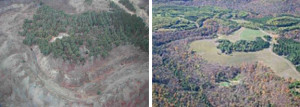The process of resolving problems such as mine fires, mine subsidence, dangerous highwalls, and other hazards, which are the result of past mining practices, as well as treating acid mine drainage from abandoned mines; Activities include but are not limited to back-filling pits and mine shafts, grading culm piles to return the land back to its approximate original contour, and putting out mine fires. Priority is given to hazards that are closer to highly populated areas to reduce the threat of injury or death.
 Source: The Pennsylvania Department of Environmental Protection, Bureau of Abandoned Mine Reclamation
Source: The Pennsylvania Department of Environmental Protection, Bureau of Abandoned Mine Reclamation
Above are before and after pictures of the Dents Run AML/AMD Ecosystem Restoration Project, conducted by the PA DEP BAMR. Prior to reclamation, the site contained hazardous highwalls and highly acidic water. The reclamation project restored and re-vegetated 320 acres of abandoned mine lands that now serve as habitat for wildlife. Almost five miles of lower Dents Run were restored by neutralizing the acid mine water and can now support aquatic life for the first time in more than a century.
Want to see more pictures of AMR? Visit our Photo Gallery.
There are several programs used in Pennsylvania to reclaim and restore abandoned mine lands:
- The Surface Mining Control & Reclamation Act (SMCRA) of 1977, Title 4 “AML Trust Fund” Program, administrated by the PA DEP BAMR
- Mine-Scarred Lands Initiative, administered by the Brownfields Federal Partnership
- Reprocessing mountainous culm piles, burning them at a Co-Generation Power Plant, then back-filling deep pits and burying highwalls with the ash
- Rural Abandoned Mine Program (RAMP), administered by the Natural Resources Conservation Service (NRCS); has not been funded since 2001 and was removed from the budget when SMCRA was reauthorized in 2006












You must be logged in to post a comment.